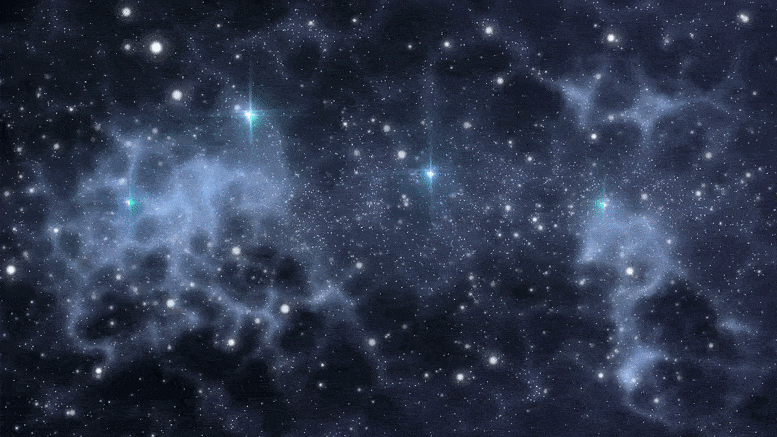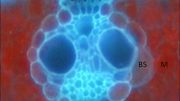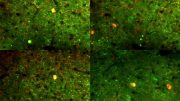
Despite decades of research, dark matter remains a cosmic mystery. Now, scientists are venturing into a new dimension to unravel its secrets.
UC Riverside dark matter research program targets assumptions about particle physics.
As its name suggests, dark matter — material which makes up about 85% of the mass in the universe — emits no light, eluding easy detection. Its properties, too, remain fairly obscure.
Now, a theoretical particle physicist at the University of California, Riverside, and colleagues have published a research paper in the Journal of High Energy Physics that shows how theories positing the existence a new type of force could help explain dark matter’s properties.
“We live in an ocean of dark matter, yet we know very little about what it could be,” said Flip Tanedo, an assistant professor of physics and astronomy and the paper’s senior author. “It is one of the most vexing known unknowns in nature. We know it exists, but we do not know how to look for it or why it hasn’t shown up where we expected it.”
Physicists have used telescopes, gigantic underground experiments, and colliders to learn more about dark matter for the last 30 years, though no positive evidence has materialized. The negative evidence, however, has forced theoretical physicists like Tanedo to think more creatively about what dark matter could be.

Flip Tanedo is an assistant professor of physics and astronomy at UC Riverside. Credit: Thomas Wasper
The new research, which proposes the existence of an extra dimension in space-time to search for dark matter, is part of an ongoing research program at UC Riverside led by Tanedo. According to this theory, some of the dark matter particles don’t behave like particles. In effect, invisible particles interact with even more invisible particles in such a way that the latter cease to behave like particles.
“The goal of my research program for the past two years is to extend the idea of dark matter ‘talking’ to dark forces,” Tanedo said. “Over the past decade, physicists have come to appreciate that, in addition to dark matter, hidden dark forces may govern dark matter’s interactions. These could completely rewrite the rules for how one ought to look for dark matter.”
If two particles of dark matter are attracted to, or repelled by, each other, then dark forces are operating. Tanedo explained that dark forces are described mathematically by a theory with extra dimensions and appear as a continuum of particles that could address puzzles seen in small galaxies.
“Our ongoing research program at UCR is a further generalization of the dark force proposal,” he said. “Our observed universe has three dimensions of space. We propose that there may be a fourth dimension that only the dark forces know about. The extra dimension can explain why dark matter has hidden so well from our attempts to study it in a lab.”

Photo shows Flip Tanedo (left), Sylvain Fichet (center), and Hai-Bo Yu. Credit: Flip Tanedo, UC Riverside
Tanedo explained that although extra dimensions may sound like an exotic idea, they are actually a mathematical trick to describe “conformal field theories” — ordinary three-dimensional theories that are highly quantum mechanical. These types of theories are mathematically rich, but do not contain conventional particles and so are typically not considered to be relevant for describing nature. The mathematical equivalence between these challenging three-dimensional theories and a more tractable extra dimensional theory is known as the holographic principle.
“Since these conformal field theories were both intractable and unusual, they hadn’t really been systematically applied to dark matter,” Tanedo added. “Instead of using that language, we work with the holographic extra-dimensional theory.”
The key feature of the extra-dimensional theory is that the force between dark matter particles is described by an infinite number of different particles with different masses called a continuum. In contrast, ordinary forces are described by a single type of particle with a fixed mass. This class of continuum-dark sectors is exciting to Tanedo because it does something “fresh and different.”
According to Tanedo, past work on dark sectors focuses primarily on theories that mimic the behavior of visible particles. His research program is exploring the more extreme types of theories that most particle physicists found less interesting, perhaps because no analogs exist in the real world.
In Tanedo’s theory, the force between dark matter particles is surprisingly different from the forces felt by ordinary matter.
“For the gravitational force or electric force that I teach in my introductory physics course, when you double the distance between two particles you reduce the force by a factor of four. A continuum force, on the other hand, is reduced by a factor of up to eight.”
What implications does this extra dimensional dark force have? Since ordinary matter may not interact with this dark force, Tanedo turned to the idea of self-interacting dark matter, an idea pioneered by Hai-Bo Yu, an associate professor of physics and astronomy at UCR who is not a coauthor on the paper. Yu showed that even in the absence of any interactions with normal matter, the effects of these dark forces could be observed indirectly in dwarf spheroidal galaxies. Tanedo’s team found the continuum force can reproduce the observed stellar motions.
“Our model goes further and makes it easier than the self-interacting dark matter model to explain the cosmic origin of dark matter,” Tanedo said.
Next, Tanedo’s team will explore a continuum version of the “dark photon” model.
“It’s a more realistic picture for a dark force,” Tanedo said. “Dark photons have been studied in great detail, but our extra-dimensional framework has a few surprises. We will also look into the cosmology of dark forces and the physics of black holes.”
Tanedo has been working diligently on identifying “blind spots” in his team’s search for dark matter.
“My research program targets one of the assumptions we make about particle physics: that the interaction of particles is well-described by the exchange of more particles,” he said. “While that is true for ordinary matter, there’s no reason to assume that for dark matter. Their interactions could be described by a continuum of exchanged particles rather than just exchanging a single type of force particle.”
Reference: “Continuum-mediated self-interacting dark matter” by Ian Chaffey, Sylvain Fichet and Philip Tanedo, 1 June 2021, Journal of High Energy Physics.
DOI: 10.1007/JHEP06(2021)008
Tanedo was joined in the research by Ian Chaffey, a postdoctoral researcher working with Tanedo; and Sylvain Fichet, a postdoctoral researcher at the International Center for Theoretical Physics – South American Institute for Fundamental Research in Brazil.
The research was funded by the U.S. Department of Energy.









There are sufficient reasons to speak that dark matter/energy contribùtes 85% of total mass of universe and present in invisìblè form ùndetected.This is inherent energy/mass that can nòt be measured or unmèasùrabĺe.This we feel as galaxìes are expandìng wìth acceleration,this can be established as a fact.Now,the phenomena like B-mesòn decaý ìnto muon paìŕs gives the same ratio of 85% with electron paìrs decay also gives proof for existance of dark energy/matter,but have no dirèct way and is simply virtual.
We can both quantify dark matter – which is ~ 25 % of the universe energy content – and dark energy – which is ~ 70 %. I think you confuse the two (and use old estimates).
Oops, sorry, the 85 % was roughly the matter (mass) proportion, and is also stated in the article.
But hence it is also explicitly quantified, which was my main point.
You don’t need another dimension to understand Dark Matter. A view of String Theory suggests that Dark Matter appears to us as an effect of string/anti-string annihilations. As you may know, quantum mechanics requires that strings must be formed as pairs in the quantum foam – a string and an anti-string – that immediately annihilate each other. Quantum mechanics also requires both the string and anti-string to be surrounded by “jitters” that reduce their monstrous vibrating energies. What if this jitter remains for a fraction of an instant after their string/anti-string annihilations? This temporary jitter would be seen by us as matter, via E=mc2, for that instant before it too returns to the foam. That’s why we never see it – the “mass” lasts only for that instant but is repeated over and over and over, all over. Specifics on this can be found in my YouTube at https://www.youtube.com/watch?v=N84yISQvGCk
Pseudoscience link.
I don’t know, but between the scientists postulating extra dimensions and the scientist actually producing dark matter in his lab from ordinary hydrogen, I’m gravitating towards the latter… https://medium.com/discourse/dark-matter-and-the-frontier-of-euv-astronomy-460f92d6ca84
I’ve read similar theories by a Russian, but the problem is the same, they do a lot of hypothesis building, some pattern recognition on emission lines and have nothing tangible to show for it.
That’s why they are “a little-known research team” and the architect art reviewer who is the article author seems more interested in putative “cold fusion” than cosmology [ https://en.wikipedia.org/wiki/Brilliant_Light_Power ]. In any case, it is obvious it is pseudoscience (larger claims are self published books).
“Critics say it lacks corroborating scientific evidence, and is a relic of cold fusion. Critical analysis of the claims have been published in the peer reviewed journals Physics Letters A, New Journal of Physics, Journal of Applied Physics, and Journal of Physics D: Applied Physics on the basis that Quantum Mechanics is valid, and that the proposed hydrino states are unphysical and incompatible with key equations of Quantum Mechanics.[6]
In 2009, IEEE Spectrum magazine characterized it as a “loser” technology because “most experts don’t believe such lower states exist, and they say the experiments don’t present convincing evidence” and mentioned that Wolfgang Ketterle had said the claims are “nonsense”.[7] BLP has announced several times that it was about to deliver commercial products based on Mill’s theories but has not delivered a working product.”
I’m not sure who suggested 85% of the matter is missing. Maybe b/c our view of everything is limited. Maybe b/c most matter accumulates together leaving lots of relatively empty space.
But this dark matter seems more like dark budgets down dark holes or dark agencies and dark military units. Seems to me Science needs some austerity measures.
This is not science, this is art & creative theorizing. Start with observations and think objectively. Better to work to gather more observations.
Nature is fairly regular and predictable. She will not reveal her secrets to the unworthy; hopefully sbe’s learned that lesson already after way too many repeats.
I’m for art and creativity and it makes Science fun. I would say creativity is more useful to engineering & theorizing. I don’t know but it seems like building theories on theories without testing and real world observations.
Knowing is generally observable or sensory. Intuition is great but how to objectively & realistically demonstrate & communicate to a fellow or to an engineer w/o data & facts? Mind control? Not so good. Keep Science civil.
The best way to know something exists in reality is to prove it. Not to hold on to the believe in your theory or imagination. The best way to be 100% certain of something is to show it and thats how others are also convinced. The simplest explanation is to show.
Trying to explain relatively empty space or why galaxies move apart over theorizing.
I’m in doubt. Keep it simple. We can achieve more this way. And as its said we’ll cross the bridge whem we get to it. Until then build on what we knowm (more accurately and precisely).
If I’m wrong I apologize. I just hope there not a good old boy network conspiring or working in the dark. (Though there probably is.)
You are the one suggesting dark matter is missing – a popular science idea not corresponding to the actual science.
The article simply relates the fact that it is observed.
The rest of your comment makes as little sense as the start of it.
You can’t just prove something when that something is hard to prove. Scientists have either stumbled upon an answer by accident while studying something else, or after hypothesizing an idea and testing it to find unexpected results. Other times, it’s from precise mathematical equations created from a hypothesis, or solid theories, showing specific consequences, such as Einstein’s general relativity predicting black holes. It took a whole lifetime to prove black holes existed.
So while you sit there and complain that scientists can’t prove things faster and spending money on nonsense, these “wasteful” research studies add ideas and discoveries for other things. You, my friend, are extremely narrow minded. Remember, if it wasn’t for Einstein, Faraday, Maxwell, Newton, and many others who “wasted” their money and lives away, you wouldn’t have a lot of the modern things you take for granted like GPS, TV, phone, car, computers, light bulbs, etc. You’d be living in some cave still.
I’ve always been of the belief that dark matter is within an unseen dimension that overlaps ours. I think this guy is on the right track with his research. Although we can’t see dark matter is it possible to use elements that interact with dark matter to trace back to its location? For example gravity interacts with dark matter which means they are linked by some shared property. So would it be possible to use gravity to trace that connection? Sort of like the way a phone call may be used in tracing to the location of the target
Ironically the gravity field particle, the graviton, is known to be massless, while cold dark matter is massive indeed.
Beliefs must be quantified like Tanedo’s et al hypothesis.
When if, more simply, the inverse square “law” doesn’t work over long distances? That at larger distances, there is a transverse wave property of gravity such that the once distance point sources of gravitational force are instead smeared over a large area – so that masses begin to attract more 1/r than 1/r^2.
“Troubled Times for Alternatives to Einstein’s Theory of Gravity
New observations of extreme astrophysical systems have “brutally and pitilessly murdered” attempts to replace Einstein’s general theory of relativity.”
[ https://www.quantamagazine.org/troubled-times-for-alternatives-to-einsteins-theory-of-gravity-20180430/ ]
Lots of extraneous stuff compared to the common dark matter theories.
“Their interactions could be described by a continuum of exchanged particles rather than just exchanging a single type of force particle.” Those Feynman diagrams would be nightmarish compared to known forces.
Flip Tanedo is a creative person, I like his basic particle physics articles [ https://www.quantumdiaries.org/2011/06/19/helicity-chirality-mass-and-the-higgs/ ].
What is good about the topic of dark matter, is the outburst of creative thinking that is creating new theories to test and challenge. It has revived my hope in science that has been hemmed in by consensus pseudo science, that has stifled the question and disallowed critical thinking. I hope against hope that it may finally rescue us from tyranny’s hostage.
CGI is all we get…lmbo Mars is a desert on Earth somewhere…wake people
check out my experience with dark matter
https://youtube.com/playlist?list=PLJzPfaepiFduofwu14T80Pvk1vEF2CMDS
This is just my best quess.
Dark energy and matter is what’s taken by black holes in this universe. All these stars and planets eaten by black holes must go somewhere, and I think it’s to a different dimension that we share spacetime with. IMHO.